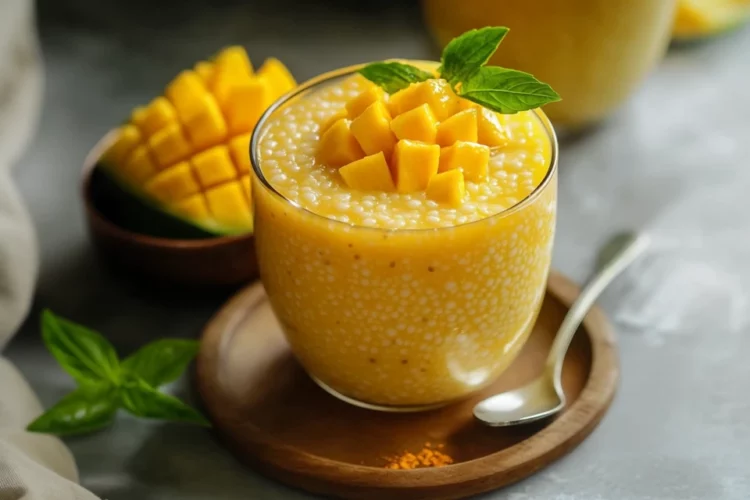There’s something undeniably comforting about a bowl of mango sago—a dessert that perfectly balances sweet, juicy mangoes with the creamy richness of coconut milk and the delightful chew of sago pearls. This dessert originates from Hong Kong-style cafés (also known as cha chaan tengs) and has since spread across Southeast Asia, becoming a beloved treat in places like Singapore, Malaysia, and Taiwan.
Growing up, mango sago was a special summer dessert in my household. I still remember the excitement of cutting into a ripe mango, its golden flesh fragrant and bursting with sweetness. The process of cooking the sago pearls, watching them turn translucent, and then combining everything into a luscious bowl of tropical goodness felt almost magical.
Mango sago is the kind of dessert that’s both simple to make and incredibly satisfying—perfect for hot days when you’re craving something refreshing but don’t want to spend hours in the kitchen. The creamy coconut base enhances the mango’s natural sweetness, while the sago pearls add a fun, chewy texture. Best of all, it’s easy to customize, whether you want it thicker, thinner, or even a little tangy with a squeeze of lime.
Let’s dive into this delicious recipe and bring a little tropical sunshine to your table!
Why You’ll Love This Recipe
- Bursting with tropical flavor – If you love mangoes, this dessert is a dream come true.
- Light and refreshing – A great way to cool down on a warm day.
- Easy to make – Minimal ingredients and effort required.
- Naturally dairy-free – Made with coconut milk for a creamy, lactose-free treat.
- Perfect for gatherings – Serve it chilled for a crowd-pleasing dessert.
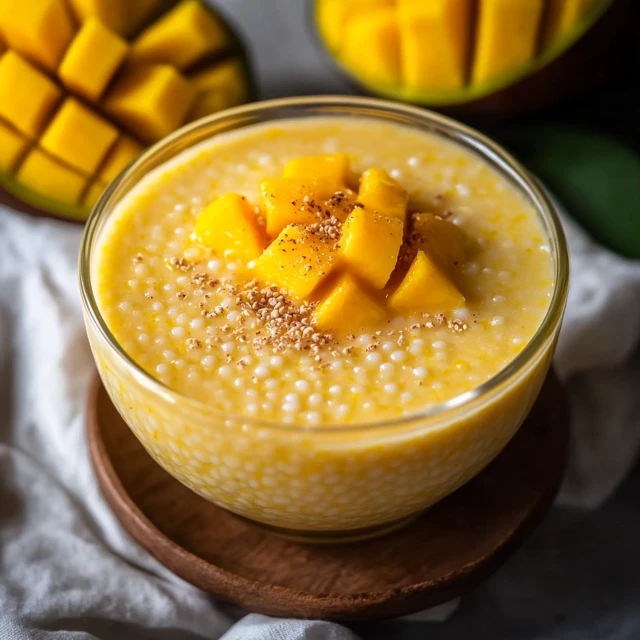
Ingredients You’ll Need
- 2 large ripe mangoes, peeled and diced
- ½ cup small sago pearls
- 1 cup coconut milk
- ½ cup evaporated milk
- ¼ cup condensed milk (adjust to taste)
- ¼ cup water
- 1-2 tablespoons sugar (optional, depending on mango sweetness)
- Ice cubes (optional, for serving)
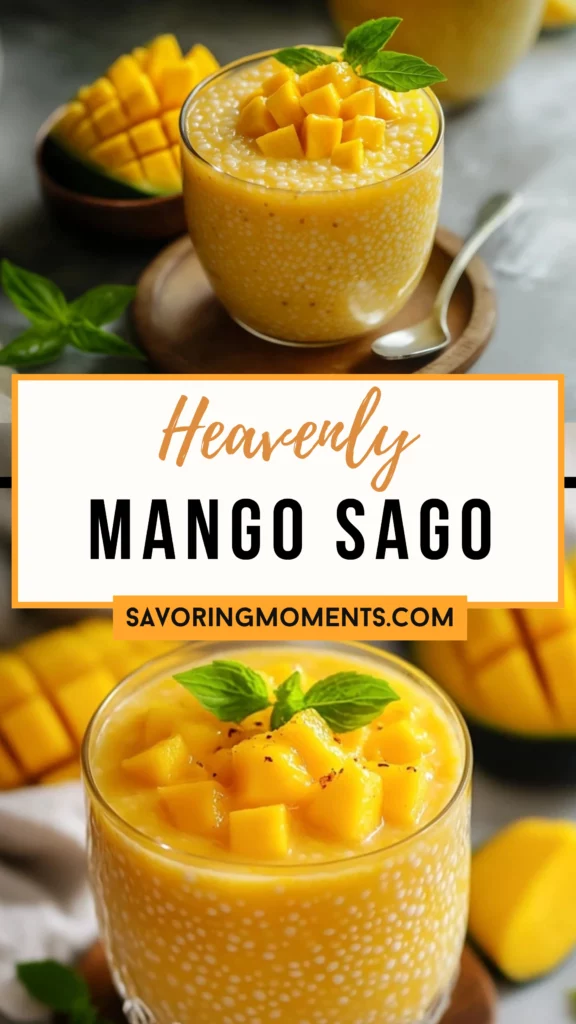
How to Make Mango Sago
Step 1: Cook the Sago Pearls
Sago pearls are the tiny, chewy pearls that add texture to this dessert. They can be tricky to cook, but with the right technique, they come out perfectly translucent every time.
- Bring a pot of water to a rolling boil. Use at least 5 cups of water to prevent the pearls from sticking together.
- Slowly add the sago pearls, stirring constantly to keep them from clumping.
- Let them cook for about 10-12 minutes, stirring occasionally. You’ll notice that the outer parts turn translucent while the centers remain white.
- Turn off the heat and cover the pot. Let the pearls sit for another 5-10 minutes, allowing them to fully cook in the residual heat.
- Once the sago is completely translucent, drain and rinse them under cold water to stop the cooking process. Set them aside in a bowl of cold water to prevent sticking.
Step 2: Prepare the Mango Mixture
The heart of this dessert is the smooth and creamy mango base.
- In a blender, add 1½ mangoes (reserve the rest for garnish), coconut milk, evaporated milk, condensed milk, and water. Blend until smooth.
- Taste the mixture—if your mangoes are very sweet, you may not need extra sugar. If needed, add 1-2 tablespoons of sugar and blend again.
- Transfer the blended mixture to a bowl or a large serving container.
Step 3: Assemble the Dessert
Now it’s time to bring everything together!
- Drain the sago pearls and mix them into the mango-coconut mixture. Stir well to combine.
- Refrigerate the dessert for at least 1 hour to allow the flavors to meld and for it to chill properly.
- When ready to serve, divide the mango sago into bowls or glasses. Top with the remaining diced mango for extra sweetness and texture.
- If you like it extra cold, add a few ice cubes or serve with a scoop of crushed ice.

Helpful Tips
- Use ripe mangoes – The sweeter and juicier your mangoes, the better your dessert will taste. Look for mangoes that give slightly when pressed.
- Don’t overcook the sago – Overcooked sago turns mushy, while undercooked sago has a chalky center. Follow the boiling and soaking method for the best results.
- Chill before serving – Mango sago tastes best when it’s cold and creamy, so don’t skip the chilling step.
- Adjust the sweetness – If your mangoes are super sweet, you may not need extra sugar. If they’re slightly tart, a bit of sugar or honey can balance the flavors.
- Add a twist – Want extra depth? A squeeze of lime juice or a sprinkle of toasted coconut flakes can elevate the flavors even more.
Recipe Details
- Prep Time: 10 minutes
- Cook Time: 15 minutes
- Total Time: 1 hour (including chilling time)
- Yield: 4 servings
- Category: Dessert
- Method: Blending and boiling
- Cuisine: Asian, Chinese, Southeast Asian
- Diet: Vegetarian, Dairy-Free
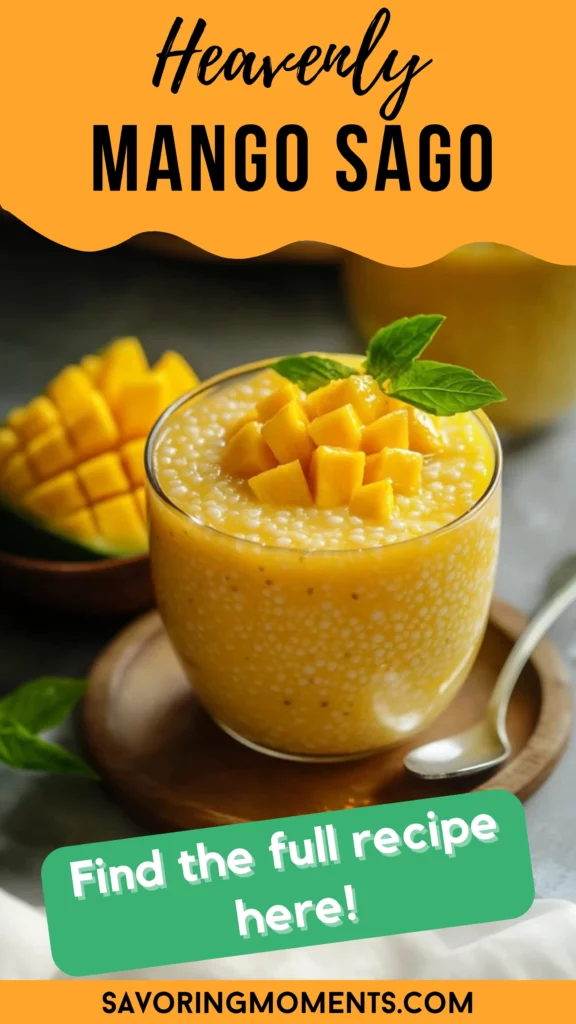
Notes
- Choosing the Right Mangoes: The best mangoes for this recipe are Ataulfo (honey mangoes), Alphonso, or Manila mangoes because they are naturally sweet and have a smooth, fiber-free texture. If using a more fibrous mango variety, strain the blended mixture for a silkier consistency.
- Cooking Sago Pearls Perfectly:
- Always use plenty of water when boiling sago to prevent sticking.
- If the pearls aren’t fully translucent after boiling, let them sit covered in hot water for a few extra minutes.
- Rinsing with cold water stops the cooking process and helps maintain the chewy texture.
- Adjusting Consistency: If you prefer a thinner dessert, add more coconut milk or water. For a thicker version, reduce the liquid slightly or refrigerate longer to let the sago absorb more moisture.
- Serving Variations:
- For extra creaminess, drizzle a little extra condensed milk on top before serving.
- If you like a bit of tang, squeeze a few drops of lime or lemon juice into the mango mixture.
- Add toasted coconut flakes or chopped mint leaves for a decorative and flavorful topping.
- Make It Vegan: To keep this recipe fully vegan, substitute evaporated milk with more coconut milk or oat milk, and use a plant-based sweetener like agave syrup instead of condensed milk.
- Storing Tips: Mango sago thickens as it sits in the fridge. If it becomes too thick, stir in a bit of extra coconut milk or water before serving.
Storage Instructions
Mango sago is best enjoyed fresh, but if you have leftovers, store them in an airtight container in the refrigerator for up to 2 days. Keep in mind that the sago pearls will continue absorbing liquid over time, so the texture may become thicker. If needed, stir in a little extra coconut milk before serving to loosen it up.
Avoid freezing this dessert, as the texture of the mango mixture and sago pearls may change after thawing.
Frequently Asked Questions
Can I make this ahead of time?
Yes! You can prepare mango sago a few hours before serving and keep it chilled in the refrigerator. Just give it a good stir before serving.
What can I use instead of coconut milk?
If you’re not a fan of coconut milk, you can substitute it with whole milk, almond milk, or oat milk for a lighter version.
Can I use frozen mango?
Absolutely! Just thaw the mango before blending. Frozen mangoes are often just as sweet and flavorful as fresh ones.
What if I can’t find sago pearls?
You can use tapioca pearls instead, though they have a slightly different texture. Cook them according to package instructions.
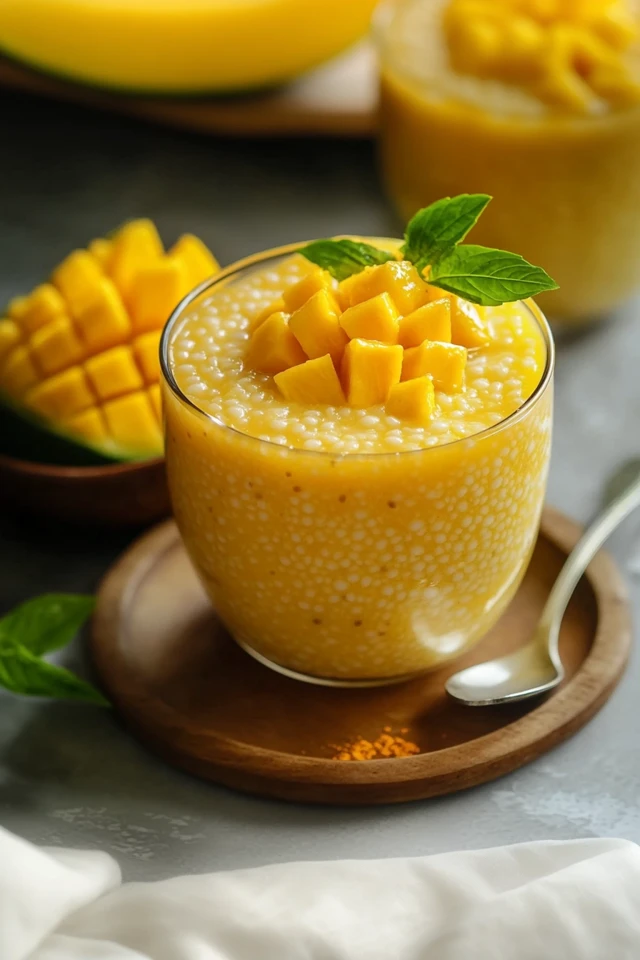
Related Recipes
If you loved this mango sago, here are some other delicious and refreshing desserts to try:
- Avocado Mango Salad with a Zesty Lime Dressing
- Fluffy Mango Pancakes
- Tropical Paradise Mango Cheesecake: A Slice of Sunshine
- Asian Mango Chicken
Conclusion
Mango sago is the perfect easy, refreshing, and tropical dessert that anyone can make. Whether you’re serving it at a summer gathering, enjoying it after dinner, or simply craving a fruity treat, this dessert never disappoints. The combination of sweet mango, creamy coconut, and chewy sago pearls makes every bite delightful.
Print
Mango Sago – A Creamy and Refreshing Tropical Dessert
Description
There’s something undeniably comforting about a bowl of mango sago—a dessert that perfectly balances sweet, juicy mangoes with the creamy richness of coconut milk and the delightful chew of sago pearls. This dessert originates from Hong Kong-style cafés (also known as cha chaan tengs) and has since spread across Southeast Asia, becoming a beloved treat in places like Singapore, Malaysia, and Taiwan.
Growing up, mango sago was a special summer dessert in my household. I still remember the excitement of cutting into a ripe mango, its golden flesh fragrant and bursting with sweetness. The process of cooking the sago pearls, watching them turn translucent, and then combining everything into a luscious bowl of tropical goodness felt almost magical.
Mango sago is the kind of dessert that’s both simple to make and incredibly satisfying—perfect for hot days when you’re craving something refreshing but don’t want to spend hours in the kitchen. The creamy coconut base enhances the mango’s natural sweetness, while the sago pearls add a fun, chewy texture. Best of all, it’s easy to customize, whether you want it thicker, thinner, or even a little tangy with a squeeze of lime.
Let’s dive into this delicious recipe and bring a little tropical sunshine to your table!
Ingredients
- 2 large ripe mangoes, peeled and diced
- ½ cup small sago pearls
- 1 cup coconut milk
- ½ cup evaporated milk
- ¼ cup condensed milk (adjust to taste)
- ¼ cup water
- 1–2 tablespoons sugar (optional, depending on mango sweetness)
- Ice cubes (optional, for serving)
Instructions
Step 1: Cook the Sago Pearls
Sago pearls are the tiny, chewy pearls that add texture to this dessert. They can be tricky to cook, but with the right technique, they come out perfectly translucent every time.
- Bring a pot of water to a rolling boil. Use at least 5 cups of water to prevent the pearls from sticking together.
- Slowly add the sago pearls, stirring constantly to keep them from clumping.
- Let them cook for about 10-12 minutes, stirring occasionally. You’ll notice that the outer parts turn translucent while the centers remain white.
- Turn off the heat and cover the pot. Let the pearls sit for another 5-10 minutes, allowing them to fully cook in the residual heat.
- Once the sago is completely translucent, drain and rinse them under cold water to stop the cooking process. Set them aside in a bowl of cold water to prevent sticking.
Step 2: Prepare the Mango Mixture
The heart of this dessert is the smooth and creamy mango base.
- In a blender, add 1½ mangoes (reserve the rest for garnish), coconut milk, evaporated milk, condensed milk, and water. Blend until smooth.
- Taste the mixture—if your mangoes are very sweet, you may not need extra sugar. If needed, add 1-2 tablespoons of sugar and blend again.
- Transfer the blended mixture to a bowl or a large serving container.
Step 3: Assemble the Dessert
Now it’s time to bring everything together!
- Drain the sago pearls and mix them into the mango-coconut mixture. Stir well to combine.
- Refrigerate the dessert for at least 1 hour to allow the flavors to meld and for it to chill properly.
- When ready to serve, divide the mango sago into bowls or glasses. Top with the remaining diced mango for extra sweetness and texture.
- If you like it extra cold, add a few ice cubes or serve with a scoop of crushed ice.
Notes
-
Choosing the Right Mangoes: The best mangoes for this recipe are Ataulfo (honey mangoes), Alphonso, or Manila mangoes because they are naturally sweet and have a smooth, fiber-free texture. If using a more fibrous mango variety, strain the blended mixture for a silkier consistency.
-
Cooking Sago Pearls Perfectly:
- Always use plenty of water when boiling sago to prevent sticking.
- If the pearls aren’t fully translucent after boiling, let them sit covered in hot water for a few extra minutes.
- Rinsing with cold water stops the cooking process and helps maintain the chewy texture.
-
Adjusting Consistency: If you prefer a thinner dessert, add more coconut milk or water. For a thicker version, reduce the liquid slightly or refrigerate longer to let the sago absorb more moisture.
-
Serving Variations:
- For extra creaminess, drizzle a little extra condensed milk on top before serving.
- If you like a bit of tang, squeeze a few drops of lime or lemon juice into the mango mixture.
- Add toasted coconut flakes or chopped mint leaves for a decorative and flavorful topping.
-
Make It Vegan: To keep this recipe fully vegan, substitute evaporated milk with more coconut milk or oat milk, and use a plant-based sweetener like agave syrup instead of condensed milk.
-
Storing Tips: Mango sago thickens as it sits in the fridge. If it becomes too thick, stir in a bit of extra coconut milk or water before serving.

